Tiffany & Co.
|
| |
| Public | |
| Traded as |
NYSE: TIF S&P 500 Component |
| Industry | Retail |
| Founded |
September 18, 1837 (as Tiffany, Young and Ellis) 1853 (as Tiffany & Company) |
| Founder | |
| Headquarters |
727 Fifth Avenue New York City, New York, U.S. 10022 |
Area served | Worldwide |
Key people |
|
| Total assets |
|
| Total equity |
|
Number of employees | 10,600 (2014)[4] |
| Website | tiffany.com |
Tiffany & Company (known colloquially as Tiffany or Tiffany's) is an American luxury jewelry and specialty retailer, headquartered in New York City.[5]
Tiffany sells jewelry, sterling silver, china, crystal, stationery, fragrances, water bottles, watches, personal accessories, as well as some leather goods.[6] Many of these goods are sold at Tiffany stores, as well as through direct-mail and corporate merchandising. Tiffany is renowned for its luxury goods and is particularly known for its diamond jewelry. Tiffany markets itself as an arbiter of taste and style,[7] and was once a purveyor to the Russian imperial family.
History
Establishment
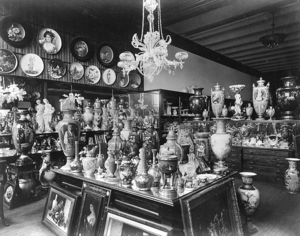
Founded by Charles Lewis Tiffany and John B. Young[8] in Brooklyn, Connecticut in 1837 as a "stationery and fancy goods emporium", the store initially sold a wide variety of stationery items, and operated as "Tiffany, Young and Ellis" in Lower Manhattan. The name was shortened to Tiffany & Company in 1853 when Charles Tiffany took control and established the firm's emphasis on jewelry.[9] Tiffany & Company has since opened stores in major cities all over the world. Unlike other stores at the time in the 1830s, Tiffany clearly marked the prices on its goods to forestall any haggling over prices. In addition, against the social norm at the time, Tiffany only accepted cash payments, and did not accept payments on credit.[10] Such practices, fixed prices for ready money, were first introduced by Palmer's of London Bridge in 1750, who employed the young Robert Owen, the later social reformer. [11]
The "Blue Book" and the Civil War
The first Tiffany's mail order catalog, known as the "Blue Book," was published in 1845 in the United States (U.S.);[12] and publishing of the catalog continues in the 21st century. In 1862, Tiffany & Company supplied the Union Army with swords (Model 1840 Cavalry Saber), flags and surgical implements. In 1867, Tiffany & Co. was the first US firm to win an award for the excellence in silverware at the Exposition Universelle in Paris. In 1868, Tiffany was incorporated.[7]
The "Gilded Age"
In 1870, the company built a new store building at 15 Union Square West, Manhattan, designed by John Kellum and costing $500,000. It was described by The New York Times as a "palace of jewels".[13] Tiffany stayed at this site until 1906.[13]
In 1877, an insignia that would become the famous New York Yankees "NY" logo was struck on a police medal of honor by Tiffany & Company; the Yankees adopted the logo in 1909. In 1878, Tiffany won the gold medal for jewelry and a grand prize for silverware at the Paris Exposition, which gave the Tiffany brand name added prestige. In 1887, Tiffany bought the French Crown Jewels, which attracted publicity and further solidified the Tiffany brand's association with high-quality diamonds.[14] The company revised the Great Seal of the United States in 1885. In 1902, after the death of Charles Lewis Tiffany, his son, Louis Comfort Tiffany, became the company's first official Design Director.[12]
1900–1999
In 1919, the company made a revision to the Medal of Honor on behalf of the United States Department of the Navy.[15] This "Tiffany Cross" version was rare because it was awarded only for combat, using the previous design for non-combat awards.[16] In 1942 the Navy established the Tiffany version for non-combat heroism, but in August 1942 the Navy eliminated the Tiffany Cross and the two-medal system.[17] In 1956, legendary designer Jean Schlumberger joined Tiffany, and Andy Warhol collaborated with Tiffany to create Tiffany Holiday Cards (circa 1956-1962).[12][18]
In 1968 Lady Bird Johnson, First Lady of the U.S. at the time, commissioned Tiffany to design a White House china-service that featured 90 flowers.[19][20] In November 1978, Tiffany & Co. was sold to Avon Products Inc. for about US$104 million in stock. However, in a 1984 Newsweek article, the Fifth Avenue Tiffany store was likened to the Macy's department store during a white sale due to the high number of inexpensive items on sale;[10] furthermore, customers complained about declining quality and service. In August 1984, Avon sold Tiffany to an investor group led by William R. Chaney for US$135.5 million in cash. Tiffany went public again in 1987 and raised about US$103.5 million from the sale of 4.5 million shares of common stock.[10]
Due to the 1990–1991 recession in the United States, Tiffany commenced an emphasis upon mass merchandising. A new campaign was launched that stressed how Tiffany could be affordable for all; for example, the company advertised that the price of diamond engagement rings started at US$850. “How to Buy a Diamond” brochures were sent to 40,000 people who called a toll-free number specifically set up to target the broader population.[10] However, to maintain its image as a luxury goods company, high-style images remained on display in Tiffany stores.[10]
2000–present
In 2000, The Tiffany & Company Foundation was established to provide grants to nonprofit organizations working in the areas of the environment and the arts.[21] In June 2004, Tiffany sued EBay, claiming that the latter was making profits from the sale of counterfeit Tiffany products;[22] however, Tiffany lost both at trial and on appeal.[23]
On January 28, 2008, a collaboration between the Japanese mobile-phone operator SoftBank and Tiffany & Co. was announced. The two companies designed a cellphone, limited to ten copies, and containing more than 400 diamonds, totaling more than 20 carats (4.0 g). Each cellphone cost more than 100,000,000 yen (£781,824).[24]
United States V. Lederhaas-Okun, Ingrid
A media report in early July 2013 revealed that former Tiffany & Company vice president Ingrid Lederhaas-Okun had been arrested and charged with stealing more than $US1.3 million of diamond bracelets, drop earrings, and other jewellery. According to prosecutors from Manhattan, U.S., the official charges filed against Ms. Lederhaas-Okun accused her of "wire fraud and interstate transportation of stolen property."[25]
Stores
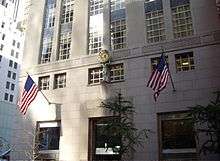
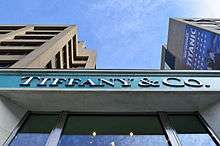
Since 1940, Tiffany's flagship store has operated at the corner of Fifth Avenue and 57th Street in Manhattan, New York City, U.S. The polished granite exterior is well known for its window displays, and the store has been the location for a number of films, including Breakfast at Tiffany's, starring Audrey Hepburn, and Sweet Home Alabama, starring Reese Witherspoon. The former Tiffany and Company Building on 37th Street is on the U.S. National Register of Historic Places.[26]
When it opened in 1990, the Tiffany & Co. store at Fairfax Square in Tysons Corner, Virginia, U.S. became the largest outside of New York City, with 14,500 sq ft (1,350 m2) of retail space.[27]
In the United Kingdom (UK), Tiffany stores are located in Terminal 5, at London's Heathrow airport (opened at the end of March 2008), in the Westfield London shopping centre in Shepherd's Bush, and in Old Bond Street, opposite the entrance to Burlington Gardens. A flagship Irish store was opened in Brown Thomas on Dublin's Grafton Street in October 2008 and is the largest of the company's European outlets. Also in October 2008, Tiffany's opened a store in Madrid, Spain, and brought the Tiffany Yellow Diamond (pictured at right) to the opening.
In Australia, Tiffany & Company's flagship store is located on Collins Street in Melbourne. Other stores include Chadstone Shopping Centre (Melbourne); Sydney (Castlereagh Street, Westfield Bondi Junction and DFS Galleria on George Street); Brisbane (Queens Plaza); and Perth (King Street).
On March 8, 2001, Tiffany's launched its first Latin American store in São Paulo, Brazil, located in the Iguatemi São Paulo shopping center.[28] The company opened a second store in the city on October 20, 2003,[29] near the famous Oscar Freire Street. The last store opened was Curitiba in September 2013, now Tiffany has stores in São Paulo, Rio de Janeiro, Brasília e Curitiba.
In 2004, Tiffany & Company created "Iridesse", a chain of stores dedicated to pearl-only jewelry. The company operated 16 stores in Florida, New Jersey, New York, Pennsylvania, California, Illinois, Massachusetts, and Virginia. However, the chain operated at a loss since its founding and the company announced in early 2009 that, despite its continued belief in the concept, it would discontinue Iridesse due to the economic climate of the time.[30]
Tiffany & Co. reported in 2006 that its location at South Coast Plaza in Costa Mesa, California, U.S. was its most profitable location, followed by the New York City flagship store, the Boston, Massachusetts outlet in Copley Place, and the Ala Moana Shopping Center in Honolulu, Hawaii.
Tiffany & Co. announced its second store opening at Pavilion Kuala Lumpur in Kuala Lumpur, Malaysia in September 2007 to coincide with the shopping mall's opening. The store consists of 1,700 sq ft (160 m2) retail space and features the same decor elements as the New York City flagship store. Later that year, other stores were opened in the U.S., such as the Natick Collection in Natick, Massachusetts, U.S., which opened in September 2007, and Mohegan Sun Erika's casino in Connecticut, U.S, and the Providence Place mall in Providence, Rhode Island, U.S., both of which opened in November 2007.
As of January 31, 2007, the company operated 64 Tiffany & Company. stores in the U.S., with a total physical area of approximately 486,000 gross square feet, as well as 103 international stores that measure approximately 306,000 gross square feet in total.
The company's expansion continued in 2011 with the opening of a store at the Multiplaza complex in Escazú, Costa Rica and a Richmond, Virginia, U.S. location in Stony Point Fashion Park on September 9, 2011.
In November 2012, the company operated in 22 countries and its worldwide net sales reached US$3.6 billion in 2011. Over 50% of the company's 2011 sales occurred in the U.S.[31]
As of January 31, 2014, the company operated 121 stores in the Americas, 72 in Asia-Pacific, 54 in Japan, 37 in Europe and 5 in "emerging markets". The 298[32] stores have 1,165,700 gross retail square footage. The company's flagship store in New York had 45,500 gross retail square footage and accounted for 8% of the company's net sales in the latest fiscal year ended January 31, 2014.[4]
The company plans to continue expanding in 2014 with the opening of a flagship store at the Centro Andino complex in Bogota, Colombia
Manufacturing
The company's manufacturing facilities produce approximately 60% of the merchandise sold —the balance, including rose-gold and almost all non-jewelry items, coming from third parties overseas. Tiffany's oversees a significant U.S. manufacturing base, with jewelry and silver goods produced in Mount Vernon, New York; majority in Cumberland, Rhode Island; and Lexington, Kentucky, while silver hollow-ware is produced in Rhode Island. The company's other subsidiaries, located in facilities outside the U.S., process, cut and polish the diamonds.
The company may increase the percentage of internally manufactured jewelry in the future, but it is not expected that Tiffany will ever manufacture all of its needs. Some of the key factors which management considered prior to its decision to outsource manufacturing included: product quality; gross margin; access to or mastery of various jewelry-making skills and technology; support for alternative capacity; and the cost of capital investments.[33]
Advertising
After the initial "Blue Book" Tiffany catalog was published in 1845, Tiffany continued to use its catalog as an advertisement strategy. The Tiffany catalog is one of the first catalogs to be printed in full color and was free until 1972. Tiffany's mail-order catalogs reached 15 million people in 1994. Tiffany also produces a corporate gift catalog each year, and corporate customers purchase Tiffany products for business gift-giving, employee service and achievement recognition awards, and customer incentives. Tiffany still produces a catalog for subscribers, but its advertisement strategy is no longer focused primarily on its catalog.[7]
In addition to the mail-order catalog, Tiffany displays its advertisements in many locations, including bus stops, in magazines and newspapers, and online. Tiffany routinely places ads in Vanity Fair, The New York Times Magazine, Architectural Digest, Money, Conde Nast Traveler, Black Enterprise, and Texas Monthly. With the advent of new technologies, Tiffany places banner advertisements in the New York Times' mobile app for the iPhone, whereby the user can download the Tiffany app free of charge.[34][35] In January 2015 they launched their first ever same-sex couple campaign.
Products
Diamonds

George Frederick Kunz, a Tiffany’s gemologist, was instrumental in the international adoption of the metric carat as a weight standard for gems, and the Tiffany standard for sterling and platinum have been adopted as U.S. standards. The 128.54 carats (25.708 g) Tiffany Yellow Diamond is usually on display in the New York City flagship store.
Tiffany designs were worn by famous U.S. families such as the Astors, Vanderbilts, Posts, Huttons and Morgans. Athletes, Hollywood stars, and European royalty were also Tiffany customers. However, like other similar diamond retailers, Tiffany's enacts a strict policy against the repurchasing of diamonds sold from its stores. In 1978, a female customer in New York City was denied after she attempted to sell back a diamond ring she had bought from Tiffany two years earlier for US$100,000. Writing for The Atlantic publication in 1982, Edward Jay Epstein explained the rationale for such a policy:
Retail jewelers, especially the prestigious Fifth Avenue stores, prefer not to buy back diamonds from customers, because the offer they would make would most likely be considered ridiculously low ... Most jewelers would prefer not to make a customer an offer that might be deemed insulting and also might undercut the widely held notion that diamonds go up in value. Moreover, since retailers generally receive their diamonds for engagement rings from wholesalers on consignment, and need not pay for them until they are sold, they would not readily risk their own cash to buy diamonds from customers. Rather than offer customers a fraction of what they paid for diamonds, retail jewelers almost invariably recommend to their clients firms that specialize in buying diamonds "retail."[36]
In November 2012, Tiffany & Co. negotiated a three-year contract to purchase diamonds from Russia's ALROSA for US$60 million annually. At the time of the ALROSA deal, the company held contracts with diamond mines in Australia, Botswana, Canada, Namibia, Russia, Sierra Leone, and South Africa.[31][37]
Colored gemstones
Tiffany offers jewelry incorporating a wide variety of colored gemstones including gems it played a role in popularizing such as tsavorite,[38] Kunzite, and morganite. In February 2015, a turquoise and aquamarine bib designed by Francesca Amfitheatrof, Tiffany’s design director, worn by Cate Blanchett at the 2015 Academy Awards, contrasted favorably with the white–diamond encrusted jewelry worn by other stars.[32]
Fragrances

In the late 1980s, Tiffany & Co. ventured into the fragrance business. Tiffany for women was launched in 1987, a floral perfume for women by perfumer Francois Demachy. At $220 per ounce, "Tiffany" was successfully marketed by major department stores across the United States.[39] Two years later, Tiffany for Men was launched in 1989 and developed by perfumer Jacques Polge. The bottle for both the men's and women's fragrance were designed by Pierre Dinand. In 1995, Tiffany launched Trueste perfume for women which was later discontinued. Currently, Tiffany continues to produce the core fragrance product for men and the product for women.
Sports awards
Tiffany's is the maker of the Vince Lombardi Trophy, made annually to be awarded to the NFL team that wins the Super Bowl that year.[40]
Tiffany & Co. is the maker of the Larry O' Brien Trophy. The trophy that is given to the winner of the NBA Finals. Tiffany & Co. Has been manufacturing the trophies since 1977.
Tiffany & Co. also made the 2010 and 2012 World Series rings for the San Francisco Giants.[41]
The MLS championship trophy was also made by Tiffany & Co.[42]
The NASCAR Sprint Cup Series' Sprint Cup trophy is also made by Tiffany & Co. and is given to the champion every year, the most recent being given to 2015 champion Kyle Busch and 2014 champion Kevin Harvick and Stewart-Haas Racing. The final ten races of the season are known as the "Chase for the Sprint Cup" as they try to get as many points in ten races as possible.
The Detroit Gold Cup trophy made originally by Tiffany & Co. in 1904, is awarded annually to the champion of the Detroit Gold Cup H1 Unlimited hydroplane race.
A £10,000 Rugby League World Cup trophy was made by Tiffanys to celebrate the centenary of Rugby league.[43]
NFL: AFC, NFC, Vince Lombardi, Pete Rozelle, NFL Rookie, Pro Bowl, Ed Thorpe,
Golf: Byron Nelson, Dicks Sporting Goods, LPGA Japan, LPGA Commissioner’s Trophy, LPGA International Crown, Northern Trust Open, Ocean Arena, Presidents Cup, FedEx Cup, Arnold Palmer Invitational,
Soccer: MLS Cup, MLS MVP,
Baseball: World Series, Home Run Derby, MVP World Series, World Baseball Classic, Commissioner’s Historic Achievement,
Horse Racing: Arlington Park, Belmont, Triple Crown, Woodlawn Vase, Polo Challenge, Kentucky Derby,
NBA: Larry O’Brien, MVP, Western Conference, Eastern Conference, WNBA: Global Community Cup
Tennis: US Open Championship, US Open Series Championship,
Other: ING NYC Marathon Medallions and Rudin Tray, NASCAR Sprint Cup, Vanderbilt Cup, Sports Illustrated Sportsman of the Year, Woodruff Cup, Viking Rowing,
Rings: NY Giants (2007, 2010) NO Saints (2009) SF Giants (2010, 2012) USA Basketball (2010, 2012) LA Kings (2012, 2014) LA Galaxy (2012) Seattle Seahawks (2012)
Current designers and collections
- Elsa Peretti's collections include Bean, Diamonds by the Yard, Open Heart, Sevillana, and Teardrop.
- Paloma Picasso's collections include Loving Heart and Sugar Stacks.
- Jean Schlumberger
- Francesca Amfitheatrof collections include The Art of the Sea and the Tiffany T collection.[32]
Gallery
 Silver tea pot
Silver tea pot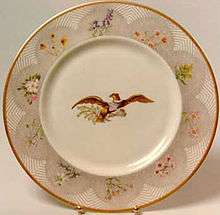 White House china service for Lady Bird Johnson
White House china service for Lady Bird Johnson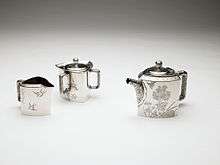 Tea Set, about 1877, held at the Birmingham Museum of Art
Tea Set, about 1877, held at the Birmingham Museum of Art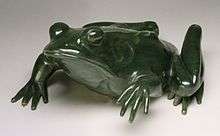 Carved frog for display at the Exposition Universelle (1900) in Paris
Carved frog for display at the Exposition Universelle (1900) in Paris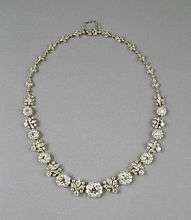 Diamond necklace ca. 1904
Diamond necklace ca. 1904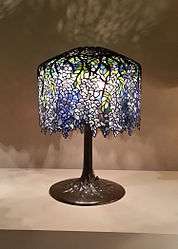 Wisteria Tiffany Studios lamp ca. 1902
Wisteria Tiffany Studios lamp ca. 1902 Hooker Emerald Brooch commissioned by Tiffany in 1950
Hooker Emerald Brooch commissioned by Tiffany in 1950
See also
Notes
- ↑ Tiffany & Co (TIF) annual SEC income statement filing via Wikinvest
- ↑ "Tiffany & Co. - Tiffany's Michael Kowalski to Retire as CEO in 2015; Frederic Cumenal, President, Named as Successor". Investor.tiffany.com. Retrieved 2015-08-01.
- 1 2 Tiffany & Co (TIF) annual SEC balance sheet filing via Wikinvest
- 1 2 "SEC Form 10-K". U.S. Securities and Exchange Commission. 2014-01-31. Retrieved 2014-10-31.
- ↑ "Tiffany & Company". New York Times. Retrieved 20 January 2016.
- ↑ Cohen, Patricia. "Tiffany_and_co". The New York Times.
- 1 2 3 "History of Tiffany & Company – FundingUniverse". Fundinguniverse.com. Retrieved 2013-02-18.
- ↑ "Tiffany & Co. For The Press | About Tiffany & Co. | Tiffany & Co. History | United States". Press.tiffany.com. Retrieved 2015-08-01.
- ↑ "CUSHION CUT Archives". Awegirls. Retrieved 2015-08-01.
- 1 2 3 4 5 "History of Tiffany & Company – FundingUniverse". Fundinguniverse.com. Retrieved 2013-02-18.
- ↑ R. J. Mitchell and M. D. R. Leys (1958). A History of London Life. London, England: Longmans, Green and Co. pp. 182–4.
- 1 2 3 "Tiffany & Company | The Tiffany Story | United States". Tiffany.com. Retrieved 2013-02-18.
- 1 2 Christopher Gray (July 2, 2006). "Before Tiffany & Co. Moved Uptown". The New York Times. Retrieved 2013-09-25.
- ↑ "Tiffany & Company | A Tiffany Diamond | Our Promise | Tiffany Diamond Certificate | United States". Tiffany.com. Retrieved 2013-02-18.
- ↑ Birnie, Michael (2003-04-27). ""Tiffany" Medal of Honor Comes to Navy Museum". U.S. Navy Museum. United States Navy. Retrieved 2010-02-15.
- ↑ Tillman, Barrett (2003). Above and Beyond: The Aviation Medals of Honor. Washington, D.C.: Smithsonian Institution Press. p. 3.
- ↑ "History of the Medal of Honor". Navy Medal of Honor (1913). Congressional Medal of Honor Society. Retrieved 2010-07-23.
- ↑ "Image not available". Corbisimages.com. Retrieved 2013-02-18.
- ↑ "Presidential China". The White House. Retrieved 2008-12-07.
- ↑ "Party Politics" Entertaining at the White House" (PDF). National First Ladies Library. Retrieved 2008-12-07.
- ↑ "The Tiffany & Co. Foundation | About the Foundation". Tiffanyandcofoundation.org. Retrieved 2013-02-18.
- ↑ "Tiffany sues eBay, says fake items sold on Web site". USA Today. March 22, 2004.
- ↑ "Tiffany, Inc. v. eBay" (PDF). April 1, 2010.
- ↑ 上戸彩:超高価ケータイ「ないしょにしてね」 (in Japanese). Sports Nippon. Archived from the original on 2008-01-30. Retrieved 2008-01-29.
- ↑ Chad Bray (4 July 2013). "Tiffany executive gem theft charges". The Australian. Retrieved 4 July 2013.
- ↑ Holly Hayes (1978-06-02). "Tiffany and Company Building - New York, New York". Gohistoric.com. Retrieved 2015-08-01.
- ↑ Potts, M. (1989) "The Swanky Side of Fairfax Square" Washington Post
- ↑ "Tiffany abre em SP primeira filial na América Latina" (in Portuguese). Estadão. Retrieved 2010-07-26.
- ↑ "Quem entra na Tiffany acaba se apaixonando" (in Portuguese). Terra. Retrieved 2010-07-26.
- ↑ Pardy, Sasha M (2009-03-13). "Tiffany & Company Shuttering Iridesse Pearl Jewelry Chain". Costar.com. Retrieved 2013-02-18.
- 1 2 "Russian diamonds to give new sparkle to Tiffany jewelry". RT.com. Autonomous Nonprofit Organization “TV-Novosti”. 28 November 2012. Retrieved 15 July 2013.
- 1 2 3 Guy Trebay (April 14, 2015). "At Tiffany, Something New Inside the Blue Box". The New York Times. Retrieved April 16, 2015.
the scene-stealing bib had the commercially desirable effect of making the million-dollar gems on other entertainers look like so much borrowed ice.
- ↑ "Edgar Pro". Yahoo.brand.edgar-online.com. Retrieved 2013-02-18.
- ↑ "Tiffany & Company continues app push with banner ads - Luxury Daily - Mobile". Luxury Daily. 2011-08-01. Retrieved 2013-02-18.
- ↑ "Tiffany & Co. Engagement Ring Finder for iPhone, iPod touch, and iPad on the iTunes App Store". Itunes.apple.com. 2011-10-22. Retrieved 2013-02-18.
- ↑ Edward Jay Epstein (1 February 1982). "Have You Ever Tried to Sell a Diamond?". The Atlantic. Retrieved 15 July 2013.
- ↑ Maria Snytkova (30 November 2012). "Russian diamonds to shine for Tiffany". pravda.ru (in English and Russian). Retrieved 15 July 2013.
- ↑ "Tsavorite Garnet". Gemstone.org. Retrieved 2015-08-01.
- ↑ "Tiffany & Co. Company History". Funding Universe. Retrieved 2013-02-18.
- ↑ "Super Bowl Trophy". ixgames. 18 September 2008.
- ↑ "Giants get Tiffany World Series rings". Associated Press. 10 April 2011.
- ↑ MLS Cup trophy tour launches this week in Houston, mlssoccer.com 19 Nov 2012
- ↑ "A history of the Rugby League World Cup". St Helens Star. 1 October 2013. Retrieved 4 January 2014.
References
- Bezdek, Richard H. American Swords and Sword Makers. Boulder, Colorado: Paladin Press, 1999.
- Bizot, Chantal, Marie-Noël de Gary, and Évelyne Possémé. The Jewels of Jean Schlumberger. New York: Harry N. Abrams, Publisher, 2001. (English translation)
- Carpenter, Charles and Janet Zapata. The Silver of Tiffany & Company, 1850–1987. Boston: Museum of Fine Arts, 1987.
- Dietz, Ulysses Grant, Jenna Weissman Joselit, and Kevin J. Smead. The Glitter and the Gold: Fashioning America’s Jewelry. Newark: The National Endowment for the Humanities, 1997.
- Duncan, Alastair, Martin Eidelberg, and Neil Harris. Masterworks of Louis Comfort Tiffany. New York: Harry N. Abrams, Inc., Publishers, 1989. Catalogue for an exhibition at the Renwick Gallery, Washington, D.C., from September 29, 1989 – March 4, 1990 and at the National Academy of Design, New York, from March 27 – July 8, 1990.
- Fashion Institute of Technology. Elsa Peretti: Fifteen of My Fifty with Tiffany. New York: Fashion Institute of Technology, 1990. Exhibition catalogue, April 24 – May 10, 1990.
- Frelinghuysen, Alice Cooney. Louis Comfort Tiffany and Laurelton Hall. New Haven, Connecticut: Yale University Press, 2006.
- Green, Annette and Linda Dyett. Secrets of Aromatic Jewelry. Paris: Flammarion, 1998.
- Hood, William P., with Roslyn Berlin and Edward Wawrynek. Tiffany Silver Flatware 1845–1905: When Dining was an Art. Suffolk, England: Antique Collectors Club, 1999.
- Loring, John. Tiffany Colored Gems. New York: Abrams, 2007. (Available Fall 2007)
- Loring, John. Greetings from Andy Warhol: Christmas at Tiffany's. New York: Abrams, 2004.
- Loring, John. Louis Comfort Tiffany at Tiffany & Co. New York: Abrams, 2002.
- Loring, John. Magnificent Tiffany Silver. New York: Abrams, 2001.
- Loring, John. The New Tiffany Tablesettings. New York: Doubleday, 1981.
- Loring, John. Paulding Farnham: Tiffany's Lost Genius. New York: Abrams, 2000.
- Loring, John. A Tiffany Christmas. New York: Doubleday, 1996.
- Loring, John. Tiffany Diamonds. New York: Abrams, 2005.
- Loring, John. Tiffany in Fashion. New York: Abrams, 2003.
- Loring, John. Tiffany Flora and Fauna. New York: Abrams, 2003.
- Loring, John. The Tiffany Gourmet Cookbook. New York: Doubleday, 1992.
- Loring, John. Tiffany Jewels. New York: Abrams, 1999.
- Loring, John. Tiffany's 150 Years. New York: Doubleday, 1987.
- Loring, John. Tiffany's Palm Beach. New York: Abrams, 2005.
- Loring, John. Tiffany Parties. New York: Doubleday, 1989.
- Loring, John. Tiffany Pearls. New York: Abrams, 2006.
- Loring, John. Tiffany Taste. New York: Doubleday, 1986.
- Loring, John. Tiffany Timepieces. New York: Abrams, 2004.
- Loring, John. Tiffany's 20th Century: A Portrait of American Style. New York: Abrams, 1997.
- Loring, John. The Tiffany Wedding. New York: Doubleday, 1988.
- Newman, Harold. An Illustrated Dictionary of Jewelry. London: Thames and Hudson, 1981.
- Phillips, Clare. Bejewelled by Tiffany: 1837–1987. New Haven and London: Yale University Press, 2006.
- Proddow, Penny and Debra Healy. American Jewelry, Glamour & Tradition. New York: Rizzoli, 1987.
- Proddow, Penny and Debra Healy. Diamonds: A Century of Spectacular Jewels. New York: Abrams, 1996.
- Purtell, Joseph. The Tiffany Touch. New York: Random House, 1971.
- Ricci, Franco Maria. Jean Schlumberger. Milan: Franco Maria Ricci, 1991.
- Schnierla, Peter and Penny Proddow. Tiffany: 150 Years of Gems and Jewelry. New York: Tiffany & Co., 1987.
- Snowman, Kenneth A. The Master Jewelers. New York: Abrams, 1990.
- Stern, Jewel. Modernism in American Silver. New Haven: Yale University Press, 2005.
- Tiffany Retrospective: Designs from Tiffany and Co., 1837–1999. Tokyo and New York: APT, 1999.
- Un Diamant Dans La Ville: Jean Schlumberger 1907–1987 Bijoux - Objets. Paris: Musee des Arts decoratifs: 1995.
- Venable, Charles L. Silver in America 1840–1940: A Century of Splendor. Dallas, Texas: Dallas Museum of Art, 1994.
- Warren, David B. et al. Marks of Achievement: Four Centuries of American Presentation Silver. Houston: Museum of Fine Arts, in association with Harry N. Abrams, Inc., 1987.
- Zapata, Janet. The Jewelry and Enamels of Louis Comfort Tiffany. New York: Harry N. Abrams, Publishers, 1993*.
External links
![]() Media related to Tiffany & Co. at Wikimedia Commons
Media related to Tiffany & Co. at Wikimedia Commons
-
- Business data for Tiffany & Co.: Google Finance
- Yahoo! Finance
- Reuters
- SEC filings
- Lace fan from Tiffany & Company, ca. 1880s, in the Staten Island Historical Society Online Collections Database
- The Story Behind the Coveted Tiffany Blue Box
Coordinates: 40°45′46″N 73°58′26″W / 40.76270°N 73.97397°W

